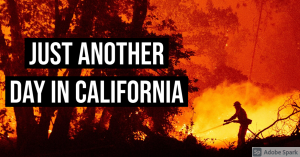Wildfires are a well-known problem in California. However, it seems that with each year, the wildfires are getting worse. There may be truth to this, as the AP reports that the current round of California wildfires are some of the worse on record and continue to sweep the state.
When it comes to California wildfires, it now takes days, not decades, to produce what had been seen as a once-in-a-lifetime occurrence.
Last weekend, a fire burning in California’s Sierra National Forest exploded in size, trapping hundreds of Labor Day holiday campers who could only be rescued by helicopters that made a series of white-knuckle flights into the smoke. Fire officials said they’d never seen a fire move so fast in forestland — 15 miles (24 kilometers) in a day.
On Wednesday, a wildfire in Plumas National Forest northeast of San Francisco spread 25 miles (40 kilometers) in a day and devoured an estimated 400 square miles (1,036 square kilometers),
In between those events, a massive fire in Monterey County doubled in size overnight, trapping 14 firefighters who had to deploy their emergency shelters; one was critically injured.
They are only the latest examples of what a half-dozen fire experts agreed is more extreme fire behavior driven by drought and warming temperatures they attribute to climate change. Among the most concerning developments is that fast-moving wildfires leave less time for warnings or evacuations.
Recently “we have seen multiple fires expand by tens of thousands of acres in a matter of hours, and 30 years or more ago that just wasn’t fire behavior that we saw,” said Jacob Bendix, a professor of geography and the environment at Syracuse University who studies wildfires.
Hotter temperatures, longer fire seasons and an estimated 140 million dead trees from a five-year drought mean that “fires in California are moving faster and growing larger,” said University of Utah fire expert Philip Dennison.
Mike Flannigan, who directs the Western Partnership for Wildland Fire Science at Canada’s University of Alberta, remembers the first report of a fire-created thunderstorm in 1986.
“They were rare events, and now they’ve become commonplace,” he said. “It’s because these fires are higher intensity.”
A prime example is the so-called Creek Fire in Sierra National Forest near Yosemite National Park, which exploded through miles of drought- and beetle-killed timber, moving so fast that it trapped hundreds of campers.
“When you have a fire run 15 miles in one day, in one afternoon, there’s no model that can predict that,” U.S. Forest Service forester Steve Lohr said. ““The fires are behaving in such a way that we’ve not seen.”
The phenomenon isn’t restricted to California. Doug Grafe, chief of Fire Protection at the Oregon Department of Forestry, said it was unprecedented in his state for fires this week to spread from the crest of the Cascade Mountains into the valleys below, and so quickly, “carrying tens of miles in one period of an afternoon and not slowing down in the evening — (there is) absolutely no context for that in this environment.”
California already has seen a record 3,900 square miles (10,100 square kilometers) burn and it’s only now is entering what traditionally is the most dangerous time for fires. Labor Day weekend brought record-breaking temperatures across the state that exacerbated what already are drought conditions in a large swath of the state. (source)
It is interesting that the current conditions seem to mirror the ‘dust bowl’ type environment that caused migrations from all over the US to the West, but in this case, a seeming migration from west to east. This inevitably going to have major political consequences, as well as will affect the future of California and other western states.
Likewise, given how many of these fires are being driven by long-term environmental consequences, it will be interesting to see how water usage and in particular, farms are affected, since a large amount of food is grown in California, and there have been concerns that in almost all states west of the Mississippi save those bordering her have serious water problems that will get worse in the future, such as with the depletion of the Ogalalla water reservoir.
Thus will it come to pass that the western USA, at some point in the future, may resemble something more of a desert? Possibly could there be further migrations eastward?
Only time can tell on these things. What we can say for now is that the serious weather changes will have impacts that are not just environmental, but also political.



